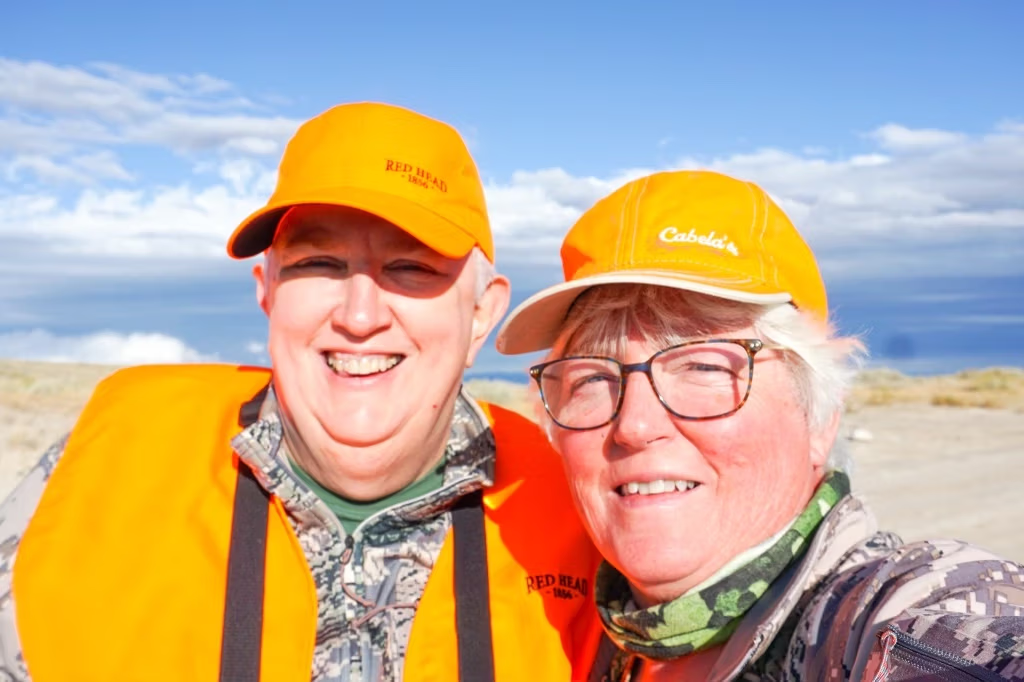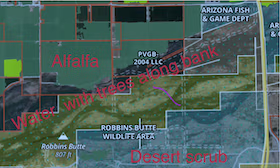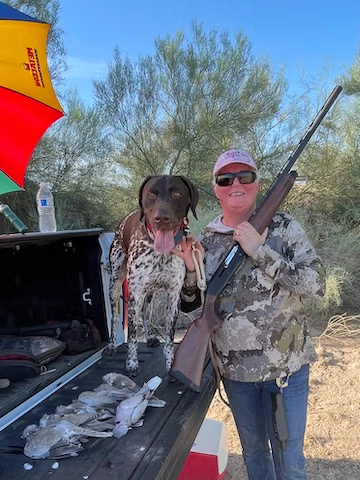Words & Images by Donna Cameron
My earliest hunting memories with my father were dove hunts. Dad was an avid bird hunter, and eagerly awaited the Labor Day dove opener every year. He had always hunted with his boyhood friend Johnny, until my sister and I decided we wanted to get in on the fun. We would wake up and catch Daddy trying to sneak out the door in the dark and each of us would sit on one of his feet, grab his leg and beg to go. Eventually, Dad relented, and informed his friend that we would tag along. Oh happy day! But, Johnny did not welcome us, and my Dad parted ways with his friend of some forty years.
From then on, we were his ever present hunting buddies. And my goodness, what fun we had. My Dad decided to include us in everything in spite of the fact that we were… “gasp”… girls: fishing, hunting, camping, gardening, reloading shotgun shells, and even working on the cars (I actually think Mom encouraged it so she could have some down time!). We tagged along, and came in very handy because we excelled at marks and retrieves. My father was blind in one eye, and we were a real help when it came to finding birds. Two eyes are better than one, and with all five of our eyes, we rarely lost a bird.
It was an exciting day when we were finally allowed to carry the single shot .410 along. My sis and I had to share the one box of shells we were allotted. Dad would always caution us to only take good shots, which made us quite shot selective! Sis and I were so fortunate to have a dad who loved his little girls and taught us we could do anything if we set our minds to it. Dad taught us how to hunt doves and quail without a bird dog, and instilled in us a love of nature that still drives us in our pursuits. My sister and I continue to go on hunting trips together, even though we live a long ways apart. Often, we talk of Dad, and how proud he would be of us, still hunting in our golden years.

If you didn’t have a dad or someone to teach you how to find and hunt dove, I am here to encourage you that dove hunting is an imminently doable activity that requires no special skills. So let’s dig in on how to find and hunt these ubiquitous birds.
Doves are the most universally accessible and popular species of game bird to hunt in the United States. In a 2021 study by the United States Fish and Wildlife Service, the population estimate for mourning doves in the United States was 194 million! This is because doves are very prolific, having anywhere from 2-6 broods per year. Doves usually have a short lifespan of 1-1.5 years, and the primary causes of mortality are starvation, predation, and disease. Hunting accounts for approximately 6% mortality, and has no appreciable impact on the overall dove population. 75% of doves die within their first year, and 50% of doves die in their second year, with or without hunting.
In 2020, there were 784,900 dove hunters, and they harvested an estimated 11,727,200 doves, averaging almost 16 birds per hunter1. Most hunters only hunt the opening weekend of dove season, averaging 2.93 days afield. Given the abundance of doves, harvesting them is both a fun and sustainable means to enjoy the outdoors and to provide a tasty meal or two to your friends and family.
Finding a place to hunt is fairly easy, even in states where there is no public land. In Texas, where I grew up but no longer live, ranchers and farmers often advertise that they will allow access to dove hunt for $50 a day. You can find these listings on Craigslist or FB, or even on the bulletin board of the local Co-op.
If you live in a state with public land, let your fingers do the walking with onX maps. With onX, it is fairly simple. Look for public land adjacent to agricultural land, with some trees and some water nearby. You can go into your map layers tab, select Trees, Crops, Covers. Then open the options for US Crop Distribution. Now you can turn on the buttons of the crops you are interested in. I look for sunflowers, corn, millet, etc. I am showing you a screenshot of a very well known area to hunt doves outside Phoenix. In the screenshot above, you can see trees, water, grasslands, and crops. This is one type of area that should pique your interest.

So how do you go about finding and hunting these prolific birds? In all hunting pursuits, there are three things that determine the location of your target species: food, water, and refuge or shelter. A day in the life of a dove includes leaving the roost, going to eat, then finding gravel or grit to aid in digestion. After graveling, the doves will seek water. Then it is siesta time and they will roost again in the middle of the day. In the evening, the cycle is repeated: eat, gravel, water, roost.
In the case of doves, food is usually a grain field. Doves love corn, sunflowers, grain sorghum (milo), millets, wheat, buckwheat, soybeans, and broadleaf plant or herbaceous plant seeds2. Doves cannot land on a vertical stalk, so they feed in fields that are cut or have leftover grain after harvesting. They will always be in open areas where it is easy to walk and feed. In the absence of agricultural fields, they will feed in short grass or areas that are thinly vegetated with open ground. Native sunflowers are a favorite.
After eating, the doves will find a spot to get gravel or grit. This is often located on a gravel or dirt road. Doves have a crop where food is first stored and exposed to enzymes, and a gizzard, where grit further breaks down the food before passing through the intestines and out of the bird.
The next stop after gravel is to get a drink. Doves prefer unobstructed still water surrounded by dry ground so they can land and walk up to the water. They suck water with their heads down rather than sip and tilt their heads back. Pigeons also do the same as both are in the Columbidae family. In my experience, stock tanks are the perfect water source, as there is always a wide area around the tank that is clear of vegetation. And there are usually trees nearby for roosting. Water found within a mile or less of where they eat is gold to the dove hunter.
Refuge or shelter is usually a tree row near or along the edge of their feeding area. They often perch on wires or in dead trees. Hedgerows with thick shrubs and smaller trees are also great. So a perfect dove hunting location would have an agricultural field with recently cut or harvested crops, a nice row of trees along the edges of the field, and water nearby.
When I hunt early dove season in AZ, the most important thing I’m looking for is shade for myself and my dog! I usually set up on a thick tree row in the shade with the sun at my back. A chair or a camo bucket or stool is quite handy. Camouflage should be used, and if you fidget or fiddle with your phone or move around a lot, the doves will see you and flare off. If you can make a ground blind from vegetation or carry a fabric ground blind to set up, you will have an advantage. Bright colors are a no no as doves have keen eyesight and will turn and be gone before you have a chance to react if they see movement or shiny objects. Also, park your car away from where you are hunting.

If possible, scout before the season. Get up and be at the location you wish to hunt about 45 minutes before sunrise. Check your regulations and know what is legal shooting light. In my state, it is 30 minutes before sunrise. Oftentimes, the doves will be coming off the roosts shortly before legal shooting time, and in especially hot locations, they will be finished eating, getting gravel, drinking, and be back roosting before 8:30am. Dove hunting is usually fast and furious the first few days of the season!
Observe where the birds roost, which way they fly when leaving the roost, and which way they fly after eating and graveling as they head to water. You may be a person that has a stock tank to hunt by, but no agricultural field to sit on. It is great to sit by water as well, especially if you happen to be hunting in the late morning or middle of the day. Just determine which way the doves will be approaching and set up a blind. As a child hunting with my dad, some of our best hunts were sitting in the shade of a mesquite tree on the backside of the dam of a stock tank and ambushing doves flying in to get a drink. As birds move between the locations of roosting, eating, graveling, and water, they take flyways, often following very specific routes. In your scouting, take note of these routes. They will often fly low following tree lines. If not tree lines, sometimes power lines, roads, creeks, or terrain features. But they will almost always follow a set route. Know them. And you will be ahead of everyone else who shows up opening morning without scouting.
Finding doves is the easy part, actually hitting one is another matter entirely. The tip I can offer is that most people miss behind the bird because they misjudged the speed or distance. I find it helpful before the season to shoot some sporting clays working on passing shots.
As far as what shotgun, choke, and shot size to use, it is your preference. I prefer an auto loader shotgun as you will be shooting a lot of shells! The auto loader absorbs some of the recoil and spares your shoulder a little bit. I use improved cylinder or modified cylinder on early season doves as they are usually a little closer in range than late season. I love shooting #7 BOSS Stingers, a copper coated bismuth non toxic shot. They are safe to use in all shotguns, even vintage shotguns like my dad’s old Winchester Model 12, made in the early 1950’s. I usually carry about two boxes of shells with me into the field. BOSS is a HerUpland national sponsor and makes a fantastic environmentally conscious product that works very well. If you haven’t gone lead free, I encourage you to give Boss a shot. When you think about the amount of lead that we shoot at doves, and all that lead ends up on the ground with birds ingesting it because they indiscriminately eat grit and gravel, it should concern you that doves are a prey bird eaten by raptors, who then get lead poisoning. In Arizona, where dove hunting is big business in the town of Yuma, about 11% of doves tested had ingested lead pellets. In another area of Arizona, Gila Valley, almost 20% of doves tested had lead pellets. Out of all the expenses of our hunting hobby, ammunition is the least expensive. So please consider going lead free.
A few other odds and ends to help you on your quest: Always have a cooler with ice and cold water. Your birds will stay much nicer if you keep them on ice, and you will last longer and be happier with some cold water. Your dog will appreciate clean cool water as well. I’ve made an area with wet dirt in the shade for my dog when hunting in the heat. Carefully watch your dog and observe for signs of heat exhaustion4. Save the adult beverages for after hunting. And don’t despair if you miss opening day and all the shooting frenzy. Some of my most productive hunts have been late in the season right before a cold front comes through. Doves migrate, and there is nothing like a cold front to get all the doves moving. In Arizona, we have a split season and some of my best hunts have been in December during the late season. Concentrate on open grass areas with gravel and nearby roosting areas and enjoy the cooler weather. When the doves are done flying in the morning, then start quail hunting!
If you have any questions, or you find yourself wanting to hunt doves in Arizona, you can reach me at donna@herupland.com, or on IG: @djc5080.
1 https://www.fws.gov/sites/default/files/documents/MourningDovePopulationStatus21.pdf
2 https://extension.missouri.edu/media/wysiwyg/Extensiondata/Pub/pdf/agguides/wildlife/ g09416.pdf
3 https://soarraptors.org/wp-content/uploads/DoveLeadResearch2009.pdf
4 https://www.akc.org/expert-advice/health/dogs-overheating-signs-symptoms-prevention/

Great article! Definitely makes me want to go dove hunting.